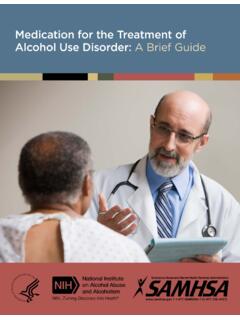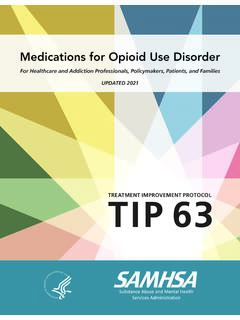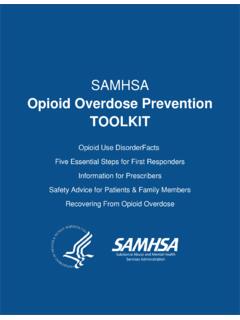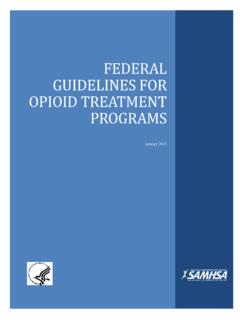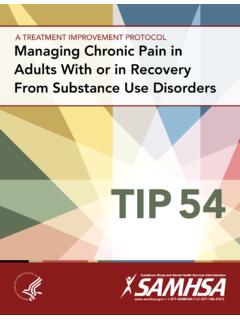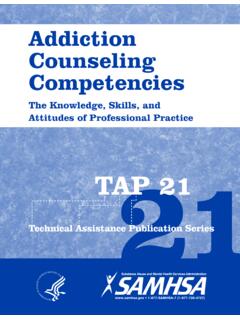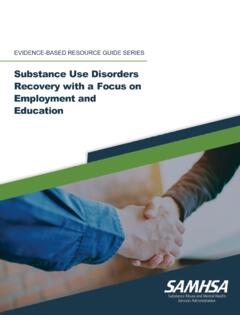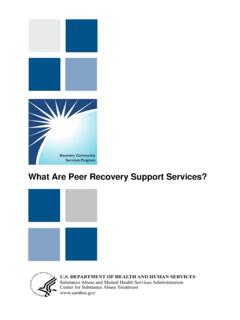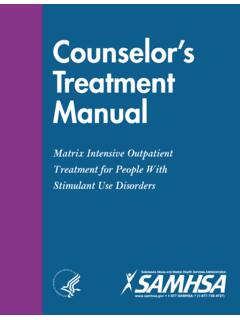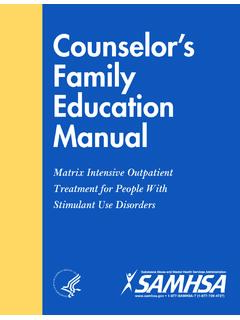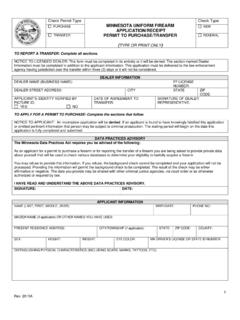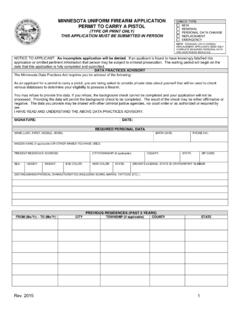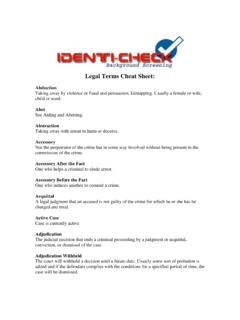Transcription of Prescription Stimulant Misuse and Prevention Among Youth ...
1 ADVISORYS ubstance Abuse and Mental HealthServices Administration1 Prescription Stimulant Misuse AND Prevention Among Youth AND YOUNG ADULTSThe Misuse of Prescription pain relievers, tranquilizers, sedatives, and stimulants Among Youth and young adults aged 12 to 25 is a major public health issue in the United States. The prevalence of Prescription drug Misuse is highest Among young adults between the ages of 18 and 25; over 11 percent report the Misuse of Prescription drugs in the past Similarly, over 4 percent of Youth between the ages of 12 and 17 report Prescription drug Misuse in the past Although the overall prevalence of Prescription drug Misuse Among Youth and young adults has declined in recent years,1 its relatively high rate Among young adults, in particular, is concerning.
2 In this age category, the rates of Prescription Stimulant Misuse are higher than the rates of Misuse for other categories of Prescription In this advisory, Prescription Stimulant Misuse includes: Using medication without a Prescription of one s own, even if with therapeutic intent; Using medication in greater amounts, more often, or longer than prescribed; Using medication in any way other than directed by a prescriber ( , non-medical use); or Using medication for recreational purposes or without therapeutic advisory occasionally uses the phrase non-medical use of Prescription stimulants when citing studies that use this of ContentsAbout Stimulants.
3 2 Types of Stimulants ..3 Prescription Stimulants ..4 Prevalence of Prescription Stimulant Use/ Misuse .. 5 Health Effects of Prescription Stimulant Misuse Among Youth and Young Adults ..5 Risk Factors for Prescription Stimulant Misuse Among Youth and Young Adults ..6 Opportunities for the Prevention of Prescription Stimulant Misuse ..8 Developing a Comprehensive, Evidence-Based Substance Use Prevention 12 Screening, Assessment, and Treatment for Prescription Stimulant Misuse ..13 Tips and Action Steps for Practitioners ..14 Tips and Action Steps for Educators.
4 15 Tips and Action Steps for Parents ..16 Resources ..18 References ..19 ADVISORY2 SAMHSA s mission is to reduce the impact of substance abuse and mental illness on America s | (1-877-726-4727) 1-800-487-4889 (TDD) Messages The Misuse of Prescription stimulants Among Youth and young adults in the United States is a major public health concern. Misuse of Prescription stimulants typically entails taking them without a Prescription or in a way other than how they were prescribed. When taken at greater than therapeutic doses, Prescription stimulants may have serious health consequences, which can include a dangerous increase in body temperature, seizures, and/or adverse cardiac events.
5 Diverted medications significantly contribute to the Misuse of Prescription stimulants. As many as one half of Youth with valid prescriptions for these medications are approached by peers to sell or give away their medication. The risk and protective factors for Prescription Stimulant Misuse are similar to those for other types of substance use, including Prescription drug Misuse , but can vary by demographic and other factors. Evidence-based Prevention programs for Prescription Stimulant Misuse are limited. However, several institutions of higher education have developed their own programs.
6 Communities have successfully implemented environmental strategies to reduce or prevent Stimulant Misuse . General substance use Prevention programs that target risk factors for substance use in general may be effective with Youth and young adults at risk for Prescription Stimulant Terms Stimulant : A class of drug that increases activity or speeds up the body s central nervous system. Prescription Stimulants: Medications that are generally used to treat ADHD and narcolepsy. Prescription Stimulant Misuse : Improper or unhealthy use of a Prescription Stimulant medication, including using medication without a Prescription of one s own; in greater amounts, more often, or longer than prescribed; or in a way other than prescribed.
7 Substance Use: The use even one time of any substance. Substance Misuse : The use of any substance in a manner, situation, amount, or frequency that can cause harm to users or those around them. For some substances or individuals, any use would constitute Misuse ( , underage drinking, injection drug use). Substance Use Disorder (SUD): Substance use disorder occurs when the recurrent use of a substance (alcohol and/or other drugs) causes clinically significant impairment, including health problems, disability, and failure to meet major responsibilities at work, school, or home.
8 diversion : Drug diversion is the unlawful transfer of Prescription drugs from their licit medical purpose to the illicit StimulantsPrescription stimulants belong to a larger class of drugs that includes both legal and illegal substances. Stimulants may temporarily increase alertness, attention, and energy,2 effects caused by the increased level of activity that occurs in the central nervous system as a result of Stimulant all stimulants have similar behavioral and physiological effects, they differ in their mechanism of action,3 or the ways in which they produce an effect.
9 Stimulants include certain foods, drinks, and tobacco products ( , coffee, chocolate, cigarettes); dietary supplements ( , appetite suppressants, energy boosters); over-the-counter medications ( , nasal decongestants); and Prescription medications ( , methylphenidate [Ritalin], amphetamine [Adderall]), and illegal substances such as cocaine and methamphetamine. When taken as prescribed, Prescription stimulants are effective for treating conditions such as attention deficit hyperactivity disorder (ADHD) and narcolepsy, a chronic sleep disorder characterized by overwhelming daytime drowsiness and sudden attacks of sleep.
10 ADVISORY3 SAMHSA s mission is to reduce the impact of substance abuse and mental illness on America s | (1-877-726-4727) 1-800-487-4889 (TDD) , the Misuse of Prescription stimulants can have serious health consequences that can be dangerous or even deadly. This advisory specifically focuses on Prescription stimulants, which are classified as Schedule II-controlled substances and can be highly addictive. Types of StimulantsThere are several categories of stimulants with various uses and indications. Figure 1 provides an overview of the different amphetamine-type and other stimulants.
